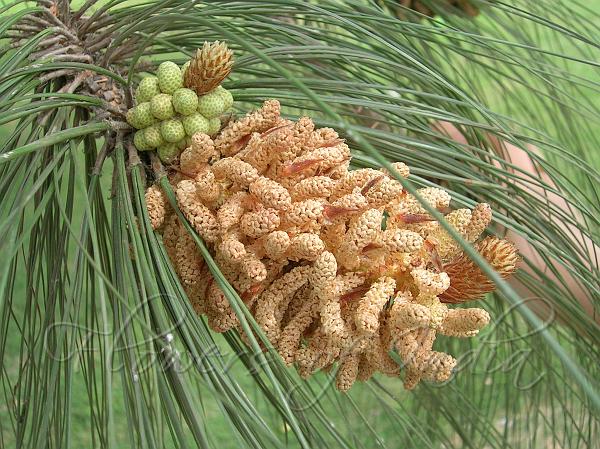|
| Chir Pine |
|

|

| File size | 697370 |
| Original date | 2/17/06 2:19 PM |
| Resolution | 2048 x 1536 |
| Flash | Flash did not fire, auto |
| Focal length | 8.0mm |
| Exposure time | 1/124s |
| Aperture | 3.2 |
| Focus Distance | |
| Metering Mode | Partial |
| Camera make | NIKON |
| Camera model | E3700 |
| Sensor type |
|
|
|
Photo: |
Botanical name: Pinus roxburghii Family: Pinaceae (pine family)
Synonyms: Pinus longifolia
Synonyms: Pinus longifolia
Among the principal pines found in India, chir pine is the most important.
Native to the Himalayas, it is good as a street tree too.
This is one of the least
exacting of the Himalayan trees growing sometimes on bare rocks where only a
few species are capable of existing. It is a resinous tree capable of yielding
resin continuously provided rill method of tapping is adopted. Erect,
round-headed evergreen tree with one or more trunks. Grows at moderate rate to
30 ft., with spread of 20 ft at maturity. The bark is red-brown, thick and
deeply fissured at the base of the trunk, thinner and flaky in the upper
crown. The leaves are needle-like, in fascicles of three, very slender, 20-35
cm long, and distinctly yellowish green. The flowers are monoecious
(individual flowers are either male or female, but both sexes can be found on
the same plant) and are pollinated by wind. The cones are ovoid conic, 12-24
cm long and 5-8 cm broad at the base when closed, green at first, ripening
glossy chestnut-brown when 24 months old. They open slowly over the next year
or so.
Medicinal uses: The turpentine obtained from the resin of all pine
trees is antiseptic,
diuretic, rubefacient and vermifuge. It is a valuable remedy used
internally in the treatment of kidney and bladder complaints and is used both
internally and as a rub and steam bath in the treatment of rheumatic
affections. It is also very beneficial to the respiratory system and so is
useful in treating diseases of the mucous membranes and respiratory complaints
such as coughs, colds, influenza and TB. Externally it is a very beneficial
treatment for a variety of skin complaints, wounds, sores, burns, boils etc
and is used in the form of liniment plasters, poultices, herbal steam baths
and inhalers. The wood is diaphoretic and stimulant. It is useful in
treating burning of the body, cough, fainting and ulcers
The turpentine obtained from the resin of all pine
trees is antiseptic,
diuretic, rubefacient and vermifuge. It is a valuable remedy used
internally in the treatment of kidney and bladder complaints and is used both
internally and as a rub and steam bath in the treatment of rheumatic
affections. It is also very beneficial to the respiratory system and so is
useful in treating diseases of the mucous membranes and respiratory complaints
such as coughs, colds, influenza and TB. Externally it is a very beneficial
treatment for a variety of skin complaints, wounds, sores, burns, boils etc
and is used in the form of liniment plasters, poultices, herbal steam baths
and inhalers. The wood is diaphoretic and stimulant. It is useful in
treating burning of the body, cough, fainting and ulcers
Medicinal uses:
 The turpentine obtained from the resin of all pine
trees is antiseptic,
diuretic, rubefacient and vermifuge. It is a valuable remedy used
internally in the treatment of kidney and bladder complaints and is used both
internally and as a rub and steam bath in the treatment of rheumatic
affections. It is also very beneficial to the respiratory system and so is
useful in treating diseases of the mucous membranes and respiratory complaints
such as coughs, colds, influenza and TB. Externally it is a very beneficial
treatment for a variety of skin complaints, wounds, sores, burns, boils etc
and is used in the form of liniment plasters, poultices, herbal steam baths
and inhalers. The wood is diaphoretic and stimulant. It is useful in
treating burning of the body, cough, fainting and ulcers
The turpentine obtained from the resin of all pine
trees is antiseptic,
diuretic, rubefacient and vermifuge. It is a valuable remedy used
internally in the treatment of kidney and bladder complaints and is used both
internally and as a rub and steam bath in the treatment of rheumatic
affections. It is also very beneficial to the respiratory system and so is
useful in treating diseases of the mucous membranes and respiratory complaints
such as coughs, colds, influenza and TB. Externally it is a very beneficial
treatment for a variety of skin complaints, wounds, sores, burns, boils etc
and is used in the form of liniment plasters, poultices, herbal steam baths
and inhalers. The wood is diaphoretic and stimulant. It is useful in
treating burning of the body, cough, fainting and ulcers| Identification credit: Tabish | Photographed in Delhi & Solan. |
• Is this flower misidentified? If yes,